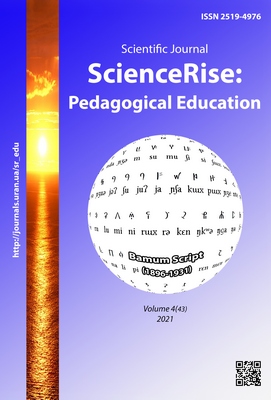Modeling of physical phenomena as a methodological means of forming a knowledge structure in physics and programming
DOI:
https://doi.org/10.15587/2519-4984.2021.237974Keywords:
methods of teaching physics, mental, materialized actions, hierarchy, evolution of knowledge structureAbstract
To bring the theoretical basis to the improvement of the methodic of carrying out laboratory works in physics and computer sciences, a study of psychological and cognitive processes that accompany the corresponding educational activity was held. The important moment of the work is the research of the mental side of educational activities in the terms of formal logic. The accompanying steps to these mental activities and the talk activity are considered. The content component of the talk activity was considered in the work as an important diagnostic factor that indicates the level of understanding of the nature of the new material or the completion of the corresponding cognitive structure. The original graphical ways of formalization of the cognitive scheme of the object activity and the logic of its formation in the context of mental and materialized education activities are presented. These ideas were used to consider the processes of educational activity on the example of the creation of a simple physical model that is realized through the Python talk with the help of Visual library. Educational activities are considered through the prism of the evolution of the structural organization of mental representation of the objects of this activity.
The research demonstrates the cyclical nature of the corresponding cognitive processes, materialized activities, and hierarchical character of the structure of knowledge that is formed in the process of educational activities in physics and programming. The correlation of these processes with the dynamics of the evolution of knowledge is settled. The conceptual ideas that could be useful for modifications of the methodic of realization of laboratory knowledge in the direction of modeling of physical processes and phenomena are formulated. Individual algorithmic problems of modeling of physical processes are considered in the research as components of the holistic system of problems. According to the point of view of the authors, in the course of the preparation of highly professional specialists in the domain of natural sciences, it is necessary to devote a lot of time to the conscious, goal-oriented formation of protocols of abstract logical and causal thinking. The methodology of such work is well formulated, especially in the well-known methods of descending step-by-step detailing and in modular programming
References
- Kholodnaya, M. A. (2019). Psikhologiya intellekta: paradoksy issledovaniya. Moscow: Yurayt, 334.
- Chuprikova, N. I. (Ed.) (2014). Differentsionno-integratsionnaya teoriya razvitiya. Moscow: Yazyki slavyanskoy kultury, 720.
- Holovin, M., Holovina, N., Holovina, N. (2018). Computer Modeling of Physical Processes and Specifics of Relevant Educational Activities. Psychological Prospects Journal, 31, 57–70. doi: http://doi.org/10.29038/2227-1376-2018-31-57-70
- Mayer, R. V. (2015). Kompyuternoe modelirovanie. Glazov: GGPI, 620.
- Miller, G. A. (1956). The magical number seven, plus or minus two: Some limits on our capacity for processing information. Psychological Review, 63 (2), 81–97. doi: http://doi.org/10.1037/h0043158
- Ivanova, G. S. (2016). Tekhnologiya programmirovaniya. Moscow: KNORUS, 334.
- Getmanova, E. E. (2005). Ispolzovanie Visual Python dlya modelirovaniya fizicheskikh protsessov. Kompyuternye instrumenty v obrazovanii, 4, 43–47.
- Windsor, M. A., English, L. Q. (2019). VPython for Introductory Mechanics: Complete Version. VPython for Introductory Mechanics. Available at: https://scholar.dickinson.edu/vpythonphysics/1
- Podolskiy, A. I. (2017). Nauchnoe nasledie P. Ya. Galperina i vyzovy XXI veka. Natsionalniy psikhologicheskiy zhurnal, 3 (27), 9–20.
- Holovin, M. B. (2008). Rozumovi ta materilizovani dii, yikh verbalne suprovodzhennia v konteksti praktychnoho navchalnoho prohramuvannia. Visnyk cherkaskoho universytetu. Pedahohichni nauky, 136, 7–13. Available at: http://evnuir.vnu.edu.ua/handle/123456789/12867
Downloads
Published
How to Cite
Issue
Section
License
Copyright (c) 2021 Nina Holovina, Mykola Holovin

This work is licensed under a Creative Commons Attribution 4.0 International License.
Our journal abides by the Creative Commons CC BY copyright rights and permissions for open access journals.
Authors, who are published in this journal, agree to the following conditions:
1. The authors reserve the right to authorship of the work and pass the first publication right of this work to the journal under the terms of a Creative Commons CC BY, which allows others to freely distribute the published research with the obligatory reference to the authors of the original work and the first publication of the work in this journal.
2. The authors have the right to conclude separate supplement agreements that relate to non-exclusive work distribution in the form in which it has been published by the journal (for example, to upload the work to the online storage of the journal or publish it as part of a monograph), provided that the reference to the first publication of the work in this journal is included.








